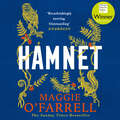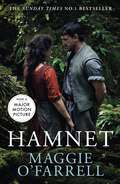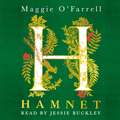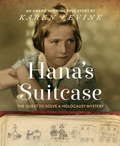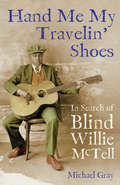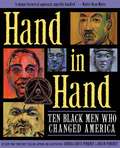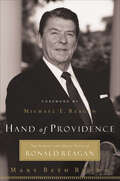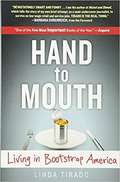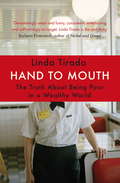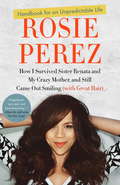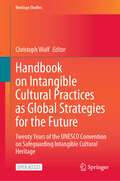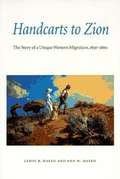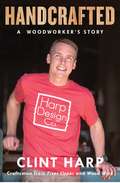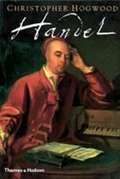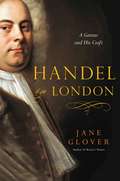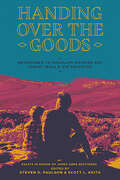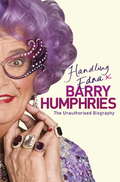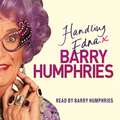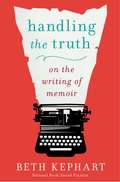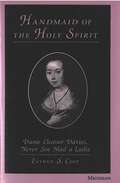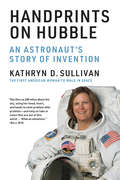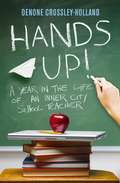- Table View
- List View
Hamnet: WINNER OF THE WOMEN'S PRIZE FOR FICTION 2020 - THE NO. 1 BESTSELLER
by Maggie O'FarrellWINNER OF THE 2020 WOMEN'S PRIZE FOR FICTION - THE SUNDAY TIMES BESTSELLER 2021'Richly sensuous... something special' The Sunday Times'A thing of shimmering wonder' David MitchellTWO EXTRAORDINARY PEOPLE. A LOVE THAT DRAWS THEM TOGETHER. A LOSS THAT THREATENS TO TEAR THEM APART.On a summer's day in 1596, a young girl in Stratford-upon-Avon takes to her bed with a fever. Her twin brother, Hamnet, searches everywhere for help. Why is nobody at home?Their mother, Agnes, is over a mile away, in the garden where she grows medicinal herbs. Their father is working in London. Neither parent knows that one of the children will not survive the week.Hamnet is a novel inspired by the son of a famous playwright. It is a story of the bond between twins, and of a marriage pushed to the brink by grief. It is also the story of a kestrel and its mistress; flea that boards a ship in Alexandria; and a glovemaker's son who flouts convention in pursuit of the woman he loves. Above all, it is a tender and unforgettable reimagining of a boy whose life has been all but forgotten, but whose name was given to one of the most celebrated plays ever written.(P)2020 Headline Publishing Group Ltd
Hamnet: WINNER OF THE WOMEN'S PRIZE FOR FICTION 2020 - THE NO. 1 BESTSELLER
by Maggie O'FarrellWINNER OF THE 2020 WOMEN'S PRIZE FOR FICTION - THE NO. 1 BESTSELLER 2021'Richly sensuous... something special' The Sunday Times'A thing of shimmering wonder' David MitchellTWO EXTRAORDINARY PEOPLE. A LOVE THAT DRAWS THEM TOGETHER. A LOSS THAT THREATENS TO TEAR THEM APART.On a summer's day in 1596, a young girl in Stratford-upon-Avon takes to her bed with a sudden fever. Her twin brother, Hamnet, searches everywhere for help. Why is nobody at home? Their mother, Agnes, is over a mile away, in the garden where she grows medicinal herbs. Their father is working in London. Neither parent knows that Hamnet will not survive the week. Hamnet is a novel inspired by the son of a famous playwright: a boy whose life has been all but forgotten, but whose name was given to one of the most celebrated plays ever written.
Hamnet: WINNER OF THE WOMEN'S PRIZE FOR FICTION 2020 - THE NO. 1 BESTSELLER
by Maggie O'FarrellA BRAND NEW RECORDING, NARRATED BY JESSIE BUCKLEY.'Richly sensuous... something special' The Sunday Times'A thing of shimmering wonder' David MitchellTWO EXTRAORDINARY PEOPLE. A LOVE THAT DRAWS THEM TOGETHER. A LOSS THAT THREATENS TO TEAR THEM APART.On a summer's day in 1596, a young girl in Stratford-upon-Avon takes to her bed with a sudden fever. Her twin brother, Hamnet, searches everywhere for help. Why is nobody at home? Their mother, Agnes, is over a mile away, in the garden where she grows medicinal herbs. Their father is working in London. Neither parent knows that Hamnet will not survive the week. Hamnet is a novel inspired by the son of a famous playwright: a boy whose life has been all but forgotten, but whose name was given to one of the most celebrated plays ever written.WINNER OF THE 2020 WOMEN'S PRIZE FOR FICTION - THE NO. 1 BESTSELLER 2021WINNER: WOMEN'S PRIZE FOR FICTIONWINNER: FICTION BOOK OF THE YEAR, BRITISH BOOK AWARDSWINNER: BOOKS ARE MY BAG READER'S CHOICE AWARDAS FEATURED ON BBC2'S BETWEEN THE COVERSSHORTLISTED: AN POST IRISH NOVEL OF THE YEAR, WALTER SCOTT PRIZE FOR HISTORICAL FICTION
Hana's Suitcase
by Karen LevineThis award-winning true Holocaust story, newly updated, connects generations through one woman's quest to find the truth behind a mysterious suitcase. In March 2000, Fumiko Ishioka, the curator of a small Holocaust education center in Tokyo, received an empty suitcase from the museum at Auschwitz. On the outside, in white paint, were the words "Hana Brady, May 16, 1931, Orphan." Fumiko and the children at the center were determined to find out who Hana was and what happened to her all those years ago, leading them to a startling and emotional discovery. The dual narrative intertwines Fumiko's international journey to find the truth about Hana Brady's fate with Hana's own compelling story of her life in a quiet Czech town, which is shattered by the arrival of the Nazis, tearing apart the family she loves. This suspense-filled work of investigative nonfiction draws in young readers and makes them active participants in the search for Hana's identity. Praise for Hana's Suitcase * "Hana wanted to become a teacher, and surely through this little book her dream is being realized." --Archbishop Desmond Tutu, from his new foreword to Hana's Suitcase * "The account . . . is part history, part suspenseful mystery . . . with an incredible climactic revelation." --Booklist
Hand Me My Travelin' Shoes: In Search of Blind Willie McTell
by Michael Gray<P>Evoking the turbulent past of the subject's time and place, this odyssey to rural Georgia peels back the many layers of Blind Willie McTell's compelling, occasionally shocking, but ultimately uplifting story. <P>Portraying him as one of the most gifted artists of his generation, this account uncovers the secrets of McTell's ancestry, the hardships he suffered--including being blind from birth--and the successes he enjoyed. <P>Traveling throughout the South and beyond, this personal and moving journey unearths a lost world of black music, exploring why he drifted in and out of the public eye, how he was "rediscovered" time and again through chance meetings, and why, until now, so little has been written about the life of this extraordinary man. <P>Part biography, part travelogue, part social history, this atmospheric, unforgettable tale connects the subject's life to the tumultuous sweep of history, exploding every stereotype about blues musicians and revealing a vulnerable milieu of poverty and discrimination, demonstrating that little may have changed in the Deep South, even today.
Hand in Hand: Ten Black Men Who Changed America
by Andrea Davis PinkneyThis book contains brief biographies of ten black men who greatly influenced American history and made a difference in the movement of anti-racism. <P><P>Winner of the Coretta Scott King Medal
Hand of Providence: The Strong and Quiet Faith of Ronald Reagan
by Mary Beth BrownA biography examining the life of the fortieth president of the United States and the impact of his faith.Ronald Reagan is one of the most popular and beloved of modern presidents, and one of the greatest presidents in America’s history. But to most scholars, biographers, and critics, the man is still an enigma. What has made him so admired and so successful in all walks of life? The answer is simple. Even when he was the most powerful man in the world, Reagan put his faith and hope in a higher power.An uplifting biography of America’s fortieth president, Hand of Providence takes a decisive look at the powerful impact Reagan’s faith had on his ideas, motives, and actions. With warmth and insight, Mary Beth Brown delves into Reagan’s spiritual journey—through all of his doubts and despair and ultimate conviction. Brown offers profound stories of God’s provision in Reagan’s life—from first making it as an actor to winning the presidency, from surviving an assassination attempt to eventually changing the face of politics and the world.
Hand to Mouth
by Linda Tirado"I've been waiting for this book for a long time. Well, not this book, because I never imagined that the book I was waiting for would be so devastatingly smart and funny, so consistently entertaining and unflinchingly on target. In fact, I would like to have written it myself - if, that is, I had lived Linda Tirado's life and extracted all the hard lessons she has learned. I am the author of Nickel and Dimed, which tells the story of my own brief attempt, as a semi-undercover journalist, to survive on low-wage retail and service jobs. Tirado is the real thing." --from the foreword by Barbara Ehrenreich, New York Times bestselling author of Nickel and Dimed We in America have certain ideas of what it means to be poor. Linda Tirado, in her signature brutally honest yet personable voice, takes all of these preconceived notions and smashes them to bits. She articulates not only what it is to be working poor in America (yes, you can be poor and live in a house and have a job, even two), but what poverty is truly like--on all levels. In her thought-provoking voice, Tirado discusses how she went from lower-middle class, to sometimes middle class, to poor and everything in between, and in doing so reveals why "poor people don't always behave the way middle-class America thinks they should."
Hand to Mouth: The Truth About Being Poor in a Wealthy World
by Linda TiradoLinda Tirado knows from experience what it is to be poor, to struggle to make ends meet. She has worked all hours as a food service worker in a chain restaurant to support her young family. She knows what it's like to have problems you wish you could fix, but no money, energy or resources to fix them, and no hope of getting any.In 2013, an essay on the everyday realities of poverty that Tirado wrote and posted online was read and shared around the world. In Hand to Mouth, she gives a searing, witty and clear-eyed insider account of being poor in the world's richest nation. She looks at how ordinary people fall or are born into the poverty trap, explains why the poor don't always behave in the way the middle classes think they should, and makes an urgent call for us all to understand and meet the challenges they face.
Handbook for an Unpredictable Life
by Rosie PerezOscar-nominated actress Rosie Perez's never-before-told story of surviving a harrowing childhood and of how she found success--both in and out of the Hollywood limelight. Rosie Perez first caught our attention with her fierce dance in the title sequence of Do the Right Thing and has since defined herself as a funny and talented actress who broke boundaries for Latinas in the film industry. What most people would be surprised to learn is that the woman with the big, effervescent personality has a secret straight out of a Dickens novel. At the age of three, Rosie's life was turned upside down when her mentally ill mother tore her away from the only family she knew and placed her in a Catholic children's home in New York's Westchester County. Thus began her crazily discombobulated childhood of being shuttled between "the Home," where she and other kids suffered all manners of cruelty from nuns, and various relatives' apartments in Brooklyn. Many in her circumstances would have been defined by these harrowing experiences, but with the intense determination that became her trademark, Rosie overcame the odds and made an incredible life for herself. She brings her journey vividly to life on each page of this memoir--from the vibrant streets of Brooklyn to her turbulent years in the Catholic home, and finally to film and TV sets and the LA and New York City hip-hop scenes of the 1980s and '90s. More than a page-turning read, Handbook for an Unpredictable Life is a story of survival. By turns heartbreaking and funny, it is ultimately the inspirational story of a woman who has found a hard-won place of strength and peace.
Handbook on Intangible Cultural Practices as Global Strategies for the Future: Twenty Years of the UNESCO Convention on Safeguarding Intangible Cultural Heritage (Heritage Studies)
by Christoph WulfThis open access handbook is the first to take stock of and to provide a comprehensive international interdisciplinary review of developments in living culture since the Convention on Safeguarding Intangible Cultural Heritage began in 2003. It is based on an expanded concept of culture, as it has been used in UNESCO since the 1980s and signed by more than 180 countries. The convention makes clear the significant role of the Global South in raising planetary awareness of the importance of intangible cultural practices. The first part of the book examines the relationship between the 1972 World Heritage Convention and the 2003 Convention on Intangible Cultural Heritage. The second part of the book focuses on colonialism, minorities, inequality, and the struggle for human rights. Perspectives from Nigeria, Brazil and the US show how colonialism still has a lasting effect today and what role the practices of intangible cultural heritage play in the struggles for the recognition of minorities. The third part looks at the contribution of intangible cultural heritage practices to the creation of meaning, community, and identity. How are these practices designed so that they allow as much participation as possible and lead to a successful handling of conflicts? The focus is on bottom-up processes. Part four examines several areas of aesthetics including music, dance, song, museum, architecture, and theater showing the importance of the aesthetic dimension and its contribution to the formation of individuals and communities. The fifth and final part of the book examines central problems of living culture and intangible cultural practices. This includes articles on new forms of community building, significance of digital and post-digital culture and metaphors. In the coming decades, intangible cultural heritage practices will become increasingly important for sustainable and peaceful planetary communication, to which the balance of this book and the perspectives based on it will make a significant contribution.
Handcarts to Zion: The Story of a Unique Western Migration, 1856-1860
by Leroy R. Hafen Ann W. HafenIt is unparalleled in history, the procession of Latter-Day Saints pushing handcarts from Iowa City and Florence (Omaha) to their promised Zion by the Great Salt Lake. Many of the three thousand hardy souls who trudged across thirteen hundred miles of prairie, desert, and mountain from 1856 to 1860 were European converts to the Mormon faith. Without funds for wagons and oxen, they carried their possessions in two-wheeled carts powered and aided by their own muscle and blood. Some of the weary travelers would finally be welcomed by their brethren in Salt Lake City; others would go to wayside graves or get caught in early winter storms in the Rockies and hope to be rescued by the parties sent out by Brigham Young. The migration is described in Handcarts to Zion, which draws on diaries and reports of the participants, rosters of the ten companies, and a collection of the songs sung on the trail and at "The Gathering. " LeRoy R. Hafen and Ann W. Hafen dedicated the book to his mother, Mary Ann Hafen, who wrote about the long journey in Recollections of a Handcart Pioneer of 1860: A Woman's Life on the Mormon Frontier, also a Bison Book.
Handcrafted: A Woodworker's Story
by Clint HarpClint Harp, maverick carpenter on HGTV’s smash hit Fixer Upper and the star of Wood Work on the DIY Network, presents his inspirational memoir that celebrates meaningful work, turning your craft into a career, and recognizing the importance of the journey itself.While Clint Harp is now known as Chip and Joanna Gaines’s go-to table maker on Fixer Upper and a nationally acclaimed artisan, his life has not always been the DIY dream we see on the show. Ten years ago, he played the role of what he thought was a good husband, father, and provider, dutifully working at a sales job that came with a healthy paycheck. Yet he kept coming back to his unfilled dream of building furniture. With the support of his wife, the encouragement of a mentor, and a life full of lessons, he finally took the leap, quit his job and set out on a quest to become a carpenter. Without formal training, financing, workspace, or customers, the Harps were quickly on the edge of financial collapse. Than Clint met Chip Gaines at a gas station—a chance encounter that marked the next chapter on a wild ride Clint and his wife, Kelly, wouldn’t have imagined possible. Spanning Clint’s remarkable journey—from a childhood learning carpentry and hard work at his grandfather’s knee, through his struggles to balance pursuing his dreams with supporting his family, to his partnership with Chip and Joanna Gaines and the many adventures and misadventures of filming Fixer Upper—Handcrafted is part memoir and part manual for dreamers. Clint provides unvarnished, thoughtful reflections on a path that is possible for anyone bold enough to pursue it.
Handel (Revised Edition)
by Anthony Hicks Christopher HogwoodThis is a concise biography, updated in 2007, of one of the greatest composers of Western music. Originally published in 1984, this edition has been revised and updated with an Afterward and a new Bibliography. Christopher Hogwood is a highly regarded and frequently recorded conductor and performer of the music of Handel and a major figure in the revival of Handel's operas and use of period performance practice. In addition, Anthony Hicks provides a brief biographical summary and a list of performances. The book closes with a complete list of Handel's works.
Handel in London: A Genius And His Craft
by Jane GloverA rich and evocative account of the life and work of one of the world's favorite composers—from the acclaimed author of Mozart’s Women. In 1712, a young German composer followed his princely master to London and would remain there for the rest of his life. That master would become King George II and the composer was George Freidrich Handel. Handel, then still only twenty-seven and largely self-taught, would be at the heart of music activity in London for the next four decades, composing masterpiece after masterpiece, whether the glorious coronation anthem, Zadok the Priest, operas such as Rinaldo and Alcina or the great oratorios, culminating, of course, in Messiah. Here, Jane Glover, who has conducted Handel’s work in opera houses and concert halls throughout the world, draws on her profound understanding of music and musicians to tell Handel’s story. It is a story of music-making and musicianship, but also of courts and cabals of theatrical rivalries and of eighteenth-century society. It is also, of course the story of some of the most remarkable music ever written, music that has been played and sung, and loved, in this country—and throughout the world—for three hundred years.
Handel: The Man & His Music
by Jonathan KeatesJonathan Keates original biography of Handel was hailed as a masterpiece on its publication in 1985. This fully revised and updated new edition - published to commemorate the 250th anniversary of the composers death - charts in detail Handel's life, from his youth in Germany, through his brilliantly successful Italian sojourn, to the opulence and squalor of Georgian London where he made his permanent home. For over two decades Handel was absorbed in London's heady but precarious operatic world. But even his phenomenal energy and determination could not overcome the public's growing indifference to Italian opera in the 1730s, and he turned finally to oratorio, a genre which he made peculiarly his own and in which he created some of his finest works, such as Saul, Messiah, Belshazzar and Jephtha.Over the last two decades a complete revolution in Handel's status has taken place. He is now seen both as a titanic figure in music, whose compositions have found a permanent place in the international repertoire, and as one of the world's favourite composers, with snatches of his work accompanying weddings, funerals and television commercials the world over.Skillfully interwoven with the account of Handel's life are commentaries on all his major works, as well as many less familiar pieces by this most inventive, expressive and captivating of composers. Handel was an extraordinary genius whose career abounded in reversals that would have crushed anyone with less resilience and will power, and Jonathan Keates writes about his life and work with sympathy and scrutiny.
Handel: The Man and His Music
by Jonathan KeatesA thorough biography of the great composer and brief analyses of most of his operas and oratorios by a noted British musicologist.
Handing Over The Goods: Determined to Proclaim Nothing but Christ Jesus and Him Crucified, A Festschrift in Honor of Dr. James A. Nestingen
by Steven D. Paulson Scott Leonard KeithMany festschrifts are meant to simply highlight the academic accomplishments of the honored recipient and his or her students, but Dr. James A. Nestingen is much more than an academic. Jim's life and career have involved his calling into multiple vocations. He is a dedicated husband and father, acclaimed academic, beloved teacher, preacher of Christ Jesus, and distinguished author, as well as a friend and much-loved mentor to many of us. In some cases, he even serves as a surrogate father figure.The goods being handed over are the Word of Christ Jesus which flows from the lips of one sinner to the ears of another and, by the power of the Holy Spirit, into the heart, thus turning our hearts of stone into hearts of flesh. By handing over the goods himself, Jim has influenced many people from a variety of cultural, theological, synodical, and denominational backgrounds. Those who have contributed to this volume represent the diversity of opinions that characterizes Jim's openness, kindness, and willingness to stretch himself while stretching others.
Handling Edna: The Unauthorised Biography
by Barry HumphriesThe real story behind Dame Edna, the international superstar!In this unauthorised biography of Dame Edna Everage, acquired for an unprecedented advance and in spectacular secrecy, her long-time manager and the man who was there from the very beginning, Barry Humphries, takes a behind-the-scenes, no-holds-barred look at an icon of our times. Superstar, swami, confidante and advisor to royalty, Hollywood stars and international political leaders, Dame Edna's life has catapulted her from her humble Moonee Ponds beginnings as a suburban housewife to the most elite social and artistic circles in the world. Who would have thought that this modest Australian woman could achieve so much from London to Louisiana to New York to Tokyo? Who could have anticipated her global fame? Barry Humphries certainly didn't.Dame Edna may not like this book but Barry knows everything - the who, the why and the where - and in this much-anticipated work, for the first time, he reveals all. This exhaustively researched account of Edna's roller-coaster life is essential reading for scholars, female achievers, fans of Dame Edna and those who feel that behind the fairytale career lies a darker and more sinister story...
Handling Edna: The Unauthorised Biography
by Barry HumphriesIn this unauthorised biography of Dame Edna Everage, acquired for an unprecedented advance and in spectacular secrecy, her long-time manager and the man who was there from the very beginning, Barry Humphries, takes a behind-the-scenes, no-holds-barred look at an icon of our times. Superstar, swami, confidante and advisor to royalty, Hollywood stars and international political leaders, Dame Edna's life has catapulted her from her humble Moonee Ponds beginnings as a suburban housewife to the most elite social and artistic circles in the world. Who would have thought that this modest Australian woman could achieve so much from London to Louisiana to New York to Tokyo? Who could have anticipated her global fame? Barry Humphries certainly didn't.Dame Edna will not like this book but Barry knows everything - the who, the why and the where - and in this much-anticipated work he will, for the first time, reveal all. This exhaustively researched account of Edna's roller-coaster life will surely dominate the bestsellers lists. Essential reading for scholars, female achievers, fans of Dame Edna and those who feel that behind the fairytale career lies a darker and more sinister story.(p) 2010 Orion Publishing Group
Handling the Truth: On the Writing of Memoir
by Beth KephartIn the tradition of Anne Lamott's Bird by Bird, a critically acclaimed National Book Award finalist shares inspiration and practical advice for writing a memoir. Writing memoir is a deeply personal, and consequential, undertaking. As the acclaimed author of five memoirs spanning significant turning points in her life, Beth Kephart has been both blessed and bruised by the genre. In Handling the Truth, she thinks out loud about the form--on how it gets made, on what it means to make it, on the searing language of truth, on the thin line between remembering and imagining, and, finally, on the rights of memoirists. Drawing on proven writing lessons and classic examples, on the work of her students and on her own memories of weather, landscape, color, and love, Kephart probes the wrenching and essential questions that lie at the heart of memoir. A beautifully written work in its own right, Handling the Truth is Kephart's memoir-writing guide for those who read or seek to write the truth.
Handmaid of the Holy Spirit: Dame Eleanor Davies, Never Soe Mad a Ladie
by Esther S. CopeOn the morning of July 28, 1625, Dame Eleanor Davis (1590-1652) heard "a great voice from heaven" tell her "There is Nintene years and a halfe to the day of Judgement and you as the meek Virgin." She believed the message came from the prophet Daniel and began immediately to explain how the books of Daniel and Revelation applied to England's history. In the next twenty-seven years, she wrote more than sixty religious and political tracts addressed to the king, the Parliament, and the public. Filled with anagrams, puns, and carefully contrived literary imagery, these tracts offered a devastating critique of the patriarchal society in which Eleanor Davies lived. Handmaid of the Holy Spirit draws upon a rich array of primary documents and provides scholars of history, literature, and religion a basis for reevaluating their conclusions about seventeenth-century England. Nonspecialists will also find the dramatic story of the fascinating and eccentric Lady Eleanor Davies compelling reading.
Handprints on Hubble: An Astronaut's Story of Invention (Lemelson Center Studies in Invention and Innovation series)
by Kathryn D. SullivanThe first American woman to walk in space recounts her experience as part of the team that launched, rescued, repaired, and maintained the Hubble Space Telescope. <p><p> The Hubble Space Telescope has revolutionized our understanding of the universe. It has, among many other achievements, revealed thousands of galaxies in what seemed to be empty patches of sky; transformed our knowledge of black holes; found dwarf planets with moons orbiting other stars; and measured precisely how fast the universe is expanding. In Handprints on Hubble, retired astronaut Kathryn Sullivan describes her work on the NASA team that made all of this possible. Sullivan, the first American woman to walk in space, recounts how she and other astronauts, engineers, and scientists launched, rescued, repaired, and maintained Hubble, the most productive observatory ever built. <p><p> Along the way, Sullivan chronicles her early life as a “Sputnik Baby,” her path to NASA through oceanography, and her initiation into the space program as one of “thirty-five new guys.” (She was also one of the first six women to join NASA's storied astronaut corps.) She describes in vivid detail what liftoff feels like inside a spacecraft (it's like “being in an earthquake and a fighter jet at the same time”), shows us the view from a spacewalk, and recounts the temporary grounding of the shuttle program after the Challenger disaster. <p><p>Sullivan explains that “maintainability” was designed into Hubble, and she describes the work of inventing the tools and processes that made on-orbit maintenance possible. Because in-flight repair and upgrade was part of the plan, NASA was able to fix a serious defect in Hubble's mirrors—leaving literal and metaphorical “handprints on Hubble.” <p><p> Handprints on Hubble was published with the support of the MIT Press Fund for Diverse Voices.
Hands Up!: A Year In The Life Of An Inner City School Teacher
by Oenone Crossley-HollandWhen Oenone Crossley-Holland started teaching at an inner city school in London, she had no idea what to expect. She just knew that there was no going back. She would have one of the most challenging and overwhelming years of her life, in which she would get involved in the lives of some wonderfully - and sometimes horrifyingly - exuberant students, and find herself tested to the limit. In this colourful and moving account, Oenone tells of the lows and unexpected highs of the sharper end of teaching. Will she make it through the year? Will she make it through another day? HANDS UP! is for anyone who's ever worked in a school or thought about teaching. It also gives a very clear answer to those who still believe that those who can't, teach.
Hands Up!: A Year in the Life of an Inner City School Teacher
by Oenone Crossley-HollandWhen Oenone Crossley-Holland started teaching at an inner city school in London, she had no idea what to expect. She just knew that there was no going back. She would have one of the most challenging and overwhelming years of her life, in which she would get involved in the lives of some wonderfully - and sometimes horrifyingly - exuberant students, and find herself tested to the limit. In this colourful and moving account, Oenone tells of the lows and unexpected highs of the sharper end of teaching. Will she make it through the year? Will she make it through another day? HANDS UP! is for anyone who's ever worked in a school or thought about teaching. It also gives a very clear answer to those who still believe that those who can't, teach.
